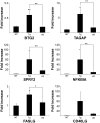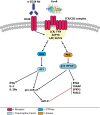Spaceflight alters expression of microRNA during T-cell activation
- PMID: 26276131
- PMCID: PMC4653058
- DOI: 10.1096/fj.15-277392
Spaceflight alters expression of microRNA during T-cell activation
Abstract
Altered immune function has been demonstrated in astronauts during spaceflights dating back to Apollo and Skylab; this could be a major barrier to long-term space exploration. We tested the hypothesis that spaceflight causes changes in microRNA (miRNA) expression. Human leukocytes were stimulated with mitogens on board the International Space Station using an onboard normal gravity control. Bioinformatics showed that miR-21 was significantly up-regulated 2-fold during early T-cell activation in normal gravity, and gene expression was suppressed under microgravity. This was confirmed using quantitative real-time PCR (n = 4). This is the first report that spaceflight regulates miRNA expression. Global microarray analysis showed significant (P < 0.05) suppression of 85 genes under microgravity conditions compared to normal gravity samples. EGR3, FASLG, BTG2, SPRY2, and TAGAP are biologically confirmed targets and are co-up-regulated with miR-21. These genes share common promoter regions with pre-mir-21; as the miR-21 matures and accumulates, it most likely will inhibit translation of its target genes and limit the immune response. These data suggest that gravity regulates T-cell activation not only by transcription promotion but also by blocking translation via noncoding RNA mechanisms. Moreover, this study suggests that T-cell activation itself may induce a sequence of gene expressions that is self-limited by miR-21.
Keywords: epigenetics; gene expression; immune response; microgravity.
© FASEB.
Figures





References
-
- Hawkins W., Zieglschmid J. (1975) Clinical aspects of crew health. In Biomedical Results of Apollo (Johnston R., Dietlein L., Berry C., eds.), pp. 43–81, National Aeronautics and Space Administration, Washington, DC
-
- Kimsey S. (1977) Hematolgoly andImmunology Studies. In Biomedical Results from Skylab (Dietlein R. J. L., ed.), pp. 249–283, National Aeronautics and Space Administration, Washington, DC
-
- Stowe R. P., Kozlova E. V., Sams C. F., Pierson D. L., Walling D. M. (2011) Latent and lytic Epstein-Barr virus gene expression in the peripheral blood of astronauts. J. Med. Virol. 83, 1071–1077 - PubMed
-
- Stowe R. P., Mehta S. K., Ferrando A. A., Feeback D. L., Pierson D. L. (2001) Immune responses and latent herpesvirus reactivation in spaceflight. Aviat. Space Environ. Med. 72, 884–891 - PubMed
-
- Konstantinova I. V., Antropova E. N., Legen’kov V. I., Zazhireĭ V. D. (1973) [Reactivity of lymphoid blood cells in the crew of “Soiuz-6,” “Soiuz-7” and “Soiuz-8” spacecraft before and after flight]. Kosm. Biol. Med. 7, 35–40 - PubMed
Publication types
MeSH terms
Substances
Grants and funding
LinkOut - more resources
Full Text Sources
Other Literature Sources
Molecular Biology Databases

